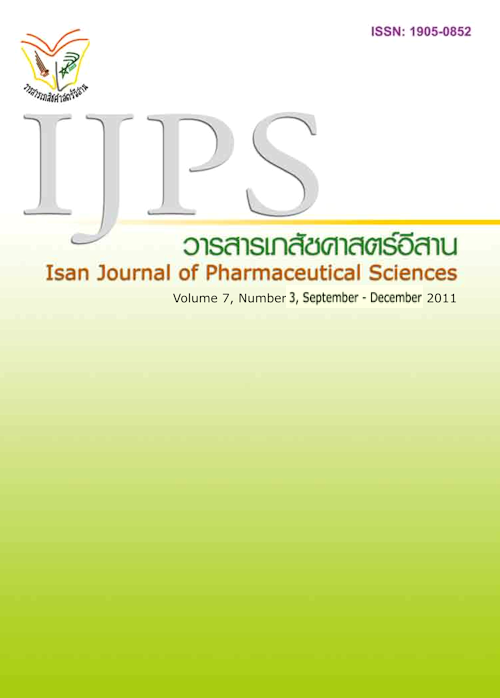Application of HPLC Method for Determination of Caffeine in Diet 3 in 1 Instant Coffee Products Commercially Sold in KhonKaen Province
Main Article Content
Abstract
Introduction: Caffeine is one of the constituent which generally found in Diet 3 in 1 instant coffee products. These products were commercially sold in Muang District, KhonKaenProvince so the aim of this study was to determine the amount of caffeine in these products. Materials and Methods: A simple HPLC method was applied to determine the amount of caffeine in these products. Liquid-liquid extraction was used for the extraction of caffeine from these samples. HPLC separation was carried out using Hypersil ODS C18 column and detected at wavelength 254 nm. This chromatographic condition using the mixture of methanol and water with constant ratio at 65:35 was found to complete resolution of caffeine. This HPLC method was validated in the topics of specifcity, accuracy, precision, linearity, limit of detection and limit of quantitation and could give reliable results. Results: From the result of this study, the amount of caffeine in these products was found from 37 mg to 107 mg per pack which can cause health problem for over consumption of these products. Conclusion: Therefore, the awareness of consumption these products should be provided for the people who would like to use these products for the diet and weight control purpose to protect from the adverse side effect from caffeine overdose.
Article Details
In the case that some parts are used by others The author must Confirm that obtaining permission to use some of the original authors. And must attach evidence That the permission has been included
References
Altun ML. HPLC Method for the Analysis of Paracetamol, Cafeine and Dipyrone. Turk J Chem 2002; 26:521-528.
Branislava S, Vukosava D, Nevena G, et al. Simultaneous HPLC determination of caffeine, theobromine and theophylline in food, drinks and herbal products. J Chromato Sci 2008; 46(2): 144-149.
Chutrtong W, Tundulawessa Y, Paungmanee P.Determinationofcaffeine in energy drinks and instant coffee mixed drinks by HPLC [Online]. 2008 May [cited 2010 May 20]. Available from: http://www.scisoc.or.th/stt/30/sec_c/paper/stt30_C0187.pdf.
Ferguson GK. Quantitative HPLC analysis of an analgesic/caffeine formulation: determination of caffeine. J Chem Ed 1998; 75(4): 467-469.
Franeta JT, Agbaba D, Eric S, et al. HPLC assay of acetylsalicylic acid, paracetamol, caffeine and Phenobarbital in tablets. Farmaco 2002;57(9):709-713.
Maryadele J O’Neil, editor. The Merck Index. Fourteenth edition. USA: Merck & CoInc; 2006.Notification of the Ministry of Public Health (No.197) B.E. 2543 (2000) Re: Coffee. [Online]. [cited 2011 January 11]. Available from:http://newsser.fda.moph.go.th/food/file/Laws/Notification%20of%20Ministry%20of%20PublicHealth/Law03P197.pdf.
PotardG, Laugel C, Baillet A, Schaefer H, Marty JP. Quantitative HPLC analysis of sunscreens and caffeine during in vitro percutaneous penetration studies. Inter J Pharmaceutics1999; 189 (2): 249-260
Sweetman SC. Martindale: The Extra Pharmocopoeia (37thed.). London: Pharmaceutical Press. 2011; 1229-1335.
Wikipedia, the free encyclopedia. Caffeine [Online]. [cited 2010 May 20]. Available from: http://en.wikipedia.org/wiki/caffeine.
Xu X, Stewart JT. HPLC methods for aspirin-caffeine-buta-bital and acetaminophen-caffeine-buta-bital mixtures in tablet dosage forms using non-porous octadecylsilane columns. J Liq Chromato 2000; 23(5): 769-779.

